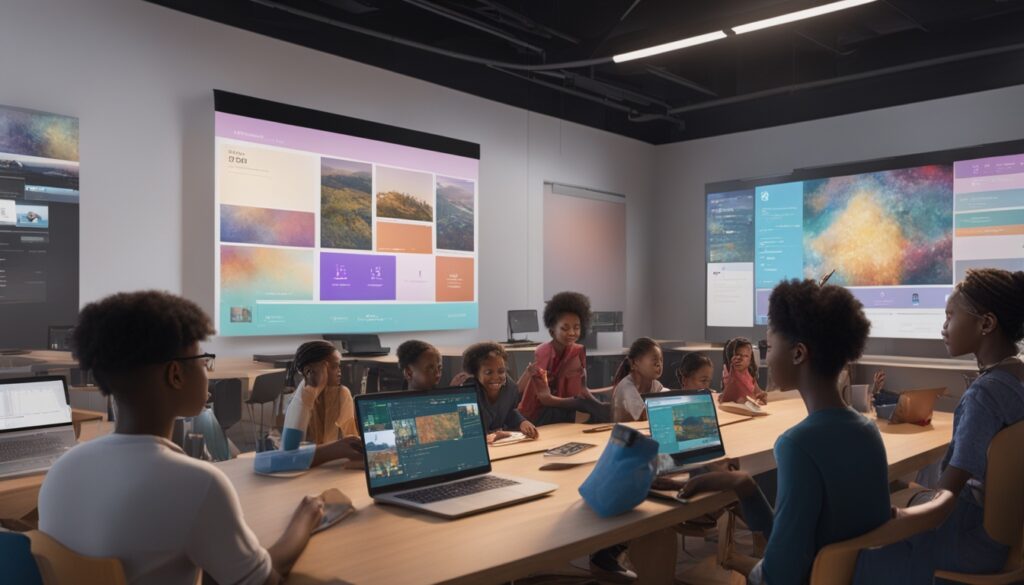Physical Address
304 North Cardinal St.
Dorchester Center, MA 02124
Physical Address
304 North Cardinal St.
Dorchester Center, MA 02124

Building a Community Around Your Online Course can foster engagement, facilitate knowledge sharing, and create a supportive network for learners.
Online courses can make learners feel alone, harming their motivation and satisfaction. But, creating a online course community can change this. It lets students talk to each other, feel the presence of their teachers, and share info. This makes a network that supports learning. Setting up clear communication plans, enhancing social presence, and using real-time interactions are crucial for a thriving online community. A strong community can make students more successful and satisfied.
The effect of community in online learning is huge. It pushes students to finish tasks, join discussions, and connect with others for help. Feeling like you belong boosts how happy and dedicated students are to their studies.
Vygotsky talked about how interaction helps us learn more. With friends and teachers helping, we can do a lot. Plus, the Community of Inquiry (COI) framework points out that talking about the topic with others is a must for really learning.
Creating a warm and welcoming online space is crucial. This means using lots of different ideas in your classes, giving chances to chat with other students, and starting with fun icebreakers so everyone feels at home.
Instructors use theories to help online courses build a strong community. Two main ones are Vygotsky’s zone of proximal development and the Community of Inquiry. These show how important talking with others is when we learn.
Vygotsky said students learn more together than by themselves. Social interaction helps students go beyond what they can do alone. This means friends and teachers are big helps in learning.
The Community of Inquiry talks about three kinds of being there: social, learning, and teaching. It helps teachers think about making a community where everyone helps each other learn. This community happens through talking about the class, sharing with the teacher, and working with other students.
It’s vital to design online courses that make everyone feel included. By using inclusive online course design, teachers can improve how students feel and learn together.
Allowing students to work together is essential in online classes. Things like jigsaw learning and team problem-solving can get students talking and learning from one another. This boosts the feeling of community in the class.
Making content that reflects different cultures is very important. It helps students see themselves in the learning and feel valued. Adding diverse examples and resources can make the learning experience richer for everyone.
Starting with good introductions helps students and the teacher get to know each other. Using video introductions or fun icebreakers can set a positive tone for the whole course. It’s a great way to start building a sense of community right away.

Instructor presence is key to creating a community in online classes. By showing you care, speaking with a friendly voice, and being authentic, a supportive space is formed. This makes students feel known and appreciated, boosting their connection to the community.
Being there for students also means showing how to communicate and work together well. This approach encourages students to connect with each other. A strong bond and feeling of fitting in boost everyone’s learning journey.
| Strategies for Building Instructor Presence | Benefits for the Online Community |
|---|---|
|
|
Put instructor presence first, and online educators can greatly impact the building of a thriving, engaging learning community. This leads to better teamwork, involvement, and a feeling of community for all students.
Creating a strong community is key to online course success. Instructors should focus on communication, social presence, and real-time interactions. These steps make the learning space lively and interesting for students.
The first step is to plan how you’ll talk to your students. You need a clear communication plan that includes updates, check-ins, and chatting before big assignments. This keeps your conversations with learners open and steady.
Making students feel like they’re really talking to others is crucial. Things like starting with video introductions, sharing updates often, and discussing student work and hobbies can make learning feel personal. It helps students invest more in their virtual connection with others.
Having live sessions can make your online space feel more like a community. These meetings let everyone connect in real time, building a stronger team spirit. It allows students and instructors alike to feel like they belong and work together more closely.

Following these approaches, instructors can build up supportive online communities. They create a more engaging setting for everyone involved in the learning process.
Getting students to share info in online classes can really boost a sense of community. You can set up study groups for them to connect, share, and work together on class tasks. Another strategy is to let students share relevant resources they find. This not only encourages resource sharing but also helps to build a supportive learning space.
Connecting with classmates and sharing knowledge can make students feel less alone. It also makes the learning experience more engaged and supportive. Setting up study groups, either on discussion boards or in virtual spaces, is a great way for them to learn from each other and feel like they belong.
Collaborative learning techniques that make students work together are key for building community. They encourage an interdependent and shared understanding. Activities like jigsaw puzzles and think-aloud pair problem solving can really get everyone involved. They push students to use each other’s insights and skills.
Online courses reach many people, but some students might not want to join in a big group. To fix this, teachers can make sub-communities within the main course. These smaller groups offer personal learning and help people find others with like interests or backgrounds.
By putting students in smaller discussion forums or breakout rooms, teachers create a closer feel. This setup boosts participation and allows for more in-depth talks. It also makes students feel more connected to the whole course.
In the end, making these sub-communities makes classes more personalized and builds a strong community feeling. It’s great for students who find big online classes scary. It helps them get more involved and feel like they belong more.

It’s key to monitor learner participation often and get their feedback. This helps see how strong the online community is and what needs to be better. You can keep up by checking the forum, looking at assignments, and talking to students.
Instructors should look out for problems like technical issues or not understanding the course. By solving these issues, the community can grow happily.
Keeping the community active takes work. Instructors need to update their plans based on what learners say. They should always aim to make a friendly and fair place to learn online.
| Key Statistic | Relevance to Online Community Engagement |
|---|---|
| 76% of global internet users are involved with online communities. | Shows how common it is to be active online. It’s crucial to measure and keep up engagement. |
| 66% of companies say that their branded communities help improve customer retention. | Proves that watching out for student part in the community and fixing problems can make them stay. It helps with keeping people loyal in the long term. |
| Users who actively engage in community activities generate 5x more revenue compared to those with minimal engagement, according to the American Society of Association Executives (ASAE). | Underlines the importance of measuring online community engagement. Also, putting in ways to get more people involved is key. |

Creating a strong community around an online course is vital. It helps students get more involved, share knowledge, and support each other. Instructors can follow models like Vygotsky’s zone of proximal development and the Community of Inquiry.
These models help design online spaces that allow students to talk to each other. They ensure that different cultures are respected and that the instructor is clearly present. The use of good planning for communication, making sure there’s a social aspect, and real-time chats all help make an active online community.
A well-thought-out community can boost how motivated, happy, and successful students are in the online class. It is crucial that we understand how important community is in online learning. We need ways to keep students engaged and feel like they belong.
By using these methods, instructors can make a learning environment where students support each other. They learn and grow in the online world.